All about garden curbs
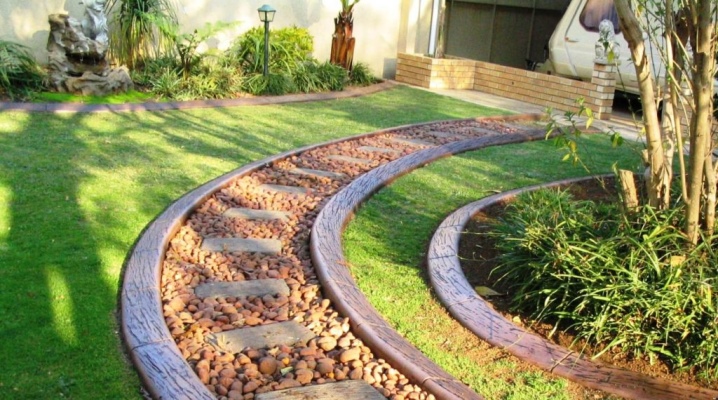
Paths and paths in the garden make moving around the territory more comfortable and easier. But all garden aesthetics quickly fade away when there are heavy rains or heavy snows in the yard. To keep the paths from “blurring” and staying the same attractive, it is necessary to install good garden curbs. We will talk about them in this article.

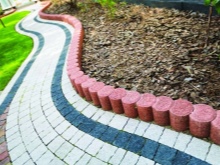
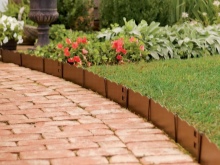
Peculiarities
Garden curbs are an integral part of a well-kept and attractive plot. The range of such products is regularly updated with new items. They are made from different materials and therefore have different performance characteristics. It is possible to choose the best option for any conditions.
Garden curbs can effectively decorate almost any area. Correctly selected, they can bring new colors to the landscape design, which are sometimes so lacking there.
Moreover, such elements can take on the role of bright accents of the situation.

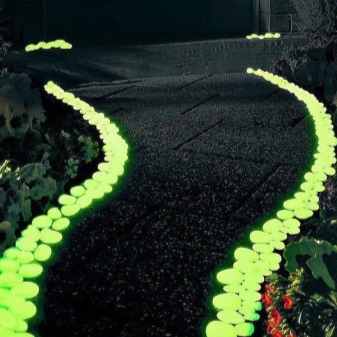
The considered garden fixtures play not only the role of spectacular decorations, but also practical components. Thanks to the curbs, all paths and paths in the garden remain neat, do not "blur" under the influence of precipitation - rain, snow, hail. Households can still move freely around their site without any inconvenience, without getting dirty. This speaks of the undoubted usefulness of well-chosen borders.
Garden curbs are attractive not only for their functionality, but also for the simplicity of their own production. Doing these things with your own hands is not difficult even for those people who have not done anything like this before. Today, many gardeners decide not to buy ready-made ones, but to install homemade borders of a suitable design on their plots.
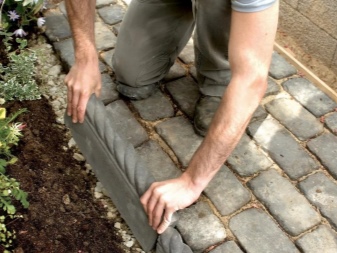
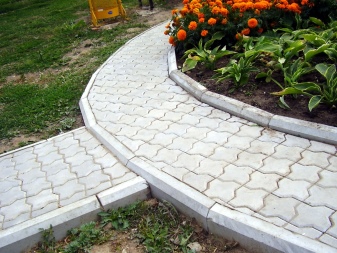
Species overview
The garden elements in question are made from different raw materials. It is very important to pay attention to this parameter when choosing the ideal option. Depending on the material of manufacture, the curbs will have their own performance characteristics and qualities, which the gardener should know about in advance. Let's take a closer look at quality curbs made from various materials and learn about their properties.
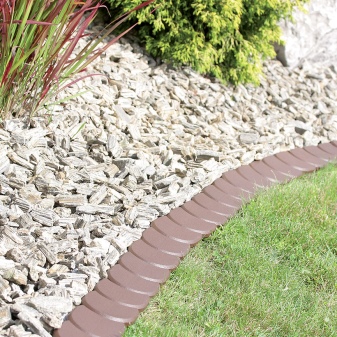
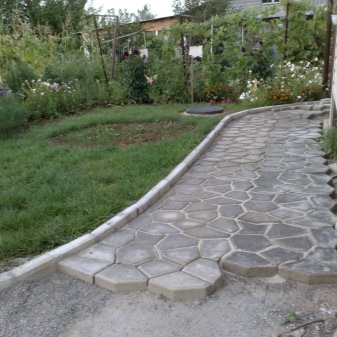
Wooden
Often in the country you can find decorative borders made of boards or other wood parts. Many gardeners prefer such products because they have a number of significant advantages.
- Wood curbs look neat and beautiful, blending in perfectly with natural garden environments.
- These products can be installed in a variety of ways.
- Well-made wooden borders for the garden can boast of excellent strength characteristics - it is very difficult to break or damage them.
- Ordinary leftover building materials can also be used to make good garden wood curbs.
- The products in question are very easy and quick to assemble, which pleases many gardeners who do not have a lot of free time.
- Wood is an environmentally friendly and safe material that cannot harm either households or nearby plantings.
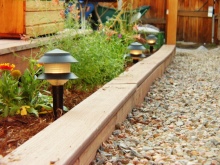
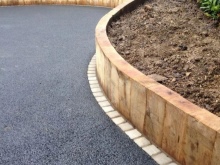
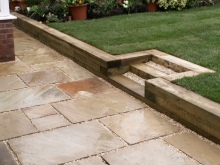
Wooden products have many advantages, but there is one serious drawback - their fragility. Even if you pre-treat the wood with antiseptic protective compounds, it can still last no more than 10 years.Installing wood curbs is very easy.
Even an inexperienced gardener who is not familiar with such procedures can cope with such work.
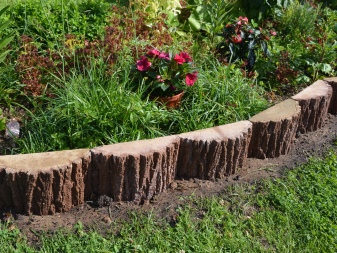
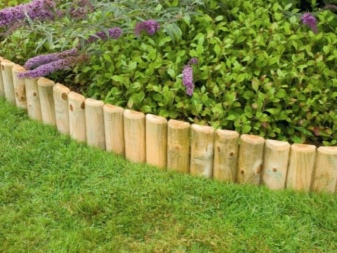
Plastic
High-quality borders made of plastic are also popular today. Such varieties are sold in many retail outlets and are presented in a rich assortment. Plastic specimens attract garden owners with their positive qualities.
- Plastic is a material that is not afraid of dampness and moisture. Under its influence, it does not deform, does not lose its attractive appearance. The same can be said about temperature resistance - temperature drops cannot harm plastic.
- Like wooden curbs, plastic curbs are very easy to install, and if necessary, just as easily disassembled. It takes very little free time.
- Polymer materials are very durable.
- Plastic will not deteriorate if it comes into contact with formulations used to irrigate horticultural crops.
- Plastic products are usually inexpensive.
- Presented in the widest range. On sale there are parts of different shapes and colors.
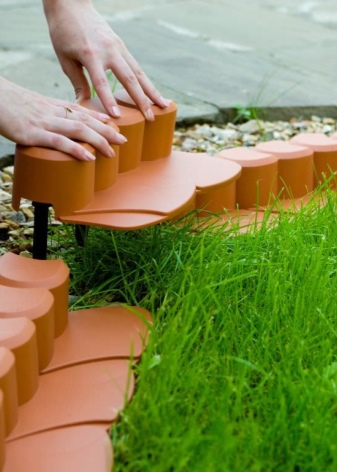
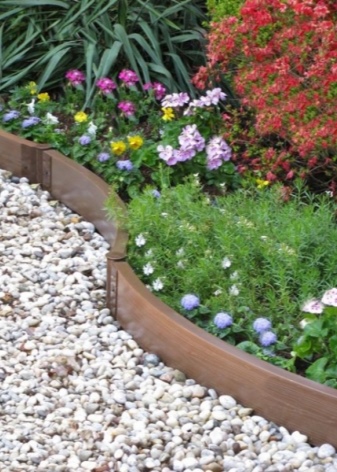
The disadvantages of plastic borders include the synthetic nature of the material, as well as low mechanical resistance. But there is no need to be afraid of high-quality plastic - it will not harm either human health or the condition of the plants growing nearby.
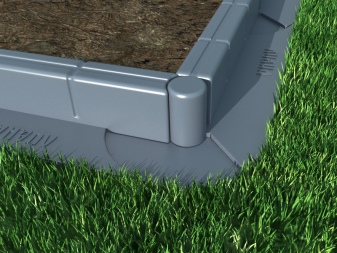
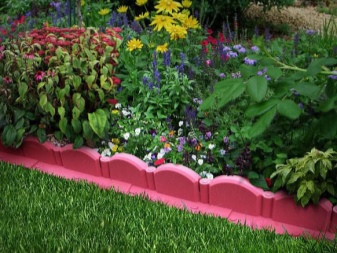
Brick
Strong curbs made of bricks are also installed in the garden. Often, the same material is used to decorate sidewalks, as well as to build a beautiful curb. Installing brick components is simple and easy. However, one must remember that such material, being in the open air, is unlikely to be able to serve for long enough.
In order for the brick to last as long as possible, it must be treated with a special waterproof varnish. You can also purchase a special clinker brick for gardening. Such material practically does not allow moisture to pass through, therefore, over time, it will not begin to deteriorate, and a garden with borders made of such bricks will acquire an aesthetic appearance.


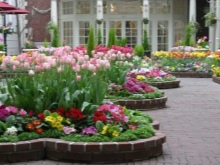
Natural stone
Natural natural stone is a rational curb material, as it is characterized by excellent aesthetic qualities, high strength and durability. Being in the open air, being exposed to negative external influences, the stone does not collapse, does not lose its former attractiveness and strength.
With stone borders, any garden will look truly gorgeous and rich.
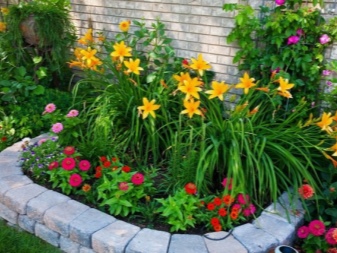

But it must be borne in mind that natural stone is quite expensive and has an impressive weight. For the design of the tracks, you need to select parts that have suitable dimensions. Often, not only garden paths are complemented with stone, but also laid out around the flower beds. If you want to give the garden a luxurious look, this material can easily cope with such a task.
It is not as difficult to build a natural stone curb on your own as it might seem at first glance. To do this, you just need to dig holes, fill up the drainage layer and tamp it. Also, a special agrofibre is often laid in the trenches so that the grass cannot grow through the installed curbs. The stone is laid so that all the parts are as close as possible to each other. Small fraction stones are poured between large elements.

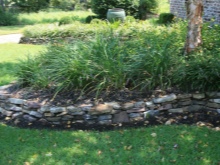
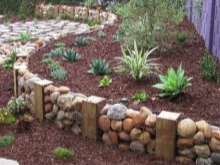
Concrete
Often, curbs made of concrete are used to decorate summer cottages. Such options are considered to be universal, since they can easily protect not only paths in the garden, but also beds, tree-trunk circles, decorative stumps, zones around trees and many other areas. From a fresh solution, it will be possible to build a frame of absolutely all sizes and shapes that the gardener desires.
Using concrete curbs, the owners can let their imagination run wild, since the design of such parts can be completely different. There are even specialized devices with the help of which it is possible to build curly top of curbs with your own hands, for example, rounded. It is not at all necessary to use freshly prepared concrete mortar to install path fences. Shards of dry material can also be installed. This will definitely not affect the appearance of landscape design badly.
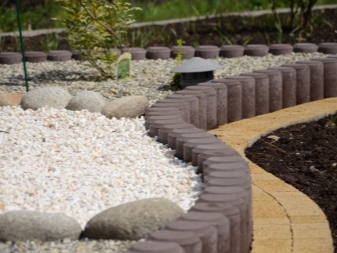
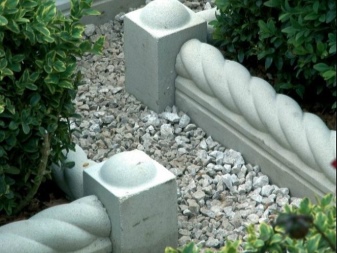
Made of metal
One of the most reliable and durable is a metal border for a garden. Most often, such products are presented in the form of a thin strip made of steel, aluminum or copper. They are mounted, like all of the above options, simply and quickly. Among the main advantages of metal borders are the following.
- They are very durable and reliable.
- They help to effectively maintain the shape of paths in the garden.
- Easy and hassle-free to install.
- They are not afraid of temperature changes.
They do not harm the soil and nearby plantings.
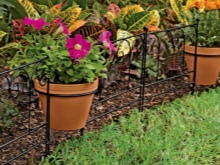
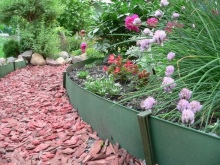
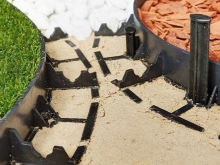
The nuances of choice
High-quality and practical garden borders must be selected correctly. Consider some of the nuances and features of choosing the right options.
- Many people choose plastic curbs for installation. It should be borne in mind that this material contains special additives, with the help of which the products can be operated in the open air. That is why such things last a long time. The immediate type of material is always indicated on plastic products.
- When choosing wooden borders for arranging a garden, one must remember that they will not last very long, even if they are regularly processed. Brick products are more practical, but they need to be coated with special products. A more wear-resistant stone can serve as a replacement for brick, but it will also cost much more. The buyer needs to decide in advance what properties he expects from the product, and how much he agrees to spend on it.
- Choose the right curb sizes. On sale you can find both small and neat, and rather large versions of various shapes. It is worth choosing the best option based on the size of the garden paths.
- Before buying, you need to make sure that the products are made from quality materials, which are free from damage, defects and cracks.
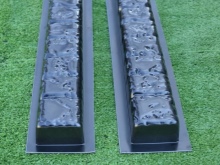

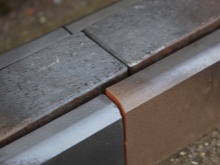
A high-quality and sturdy garden curb can be purchased in specialized stores, where everything you need for a garden and a vegetable garden is usually sold. Here customers can find products of various sizes - from 500x200x40 to 1000x200x80 mm and more. The range of colors is also huge. Sold green, gray, brown, white and even luminous border models.
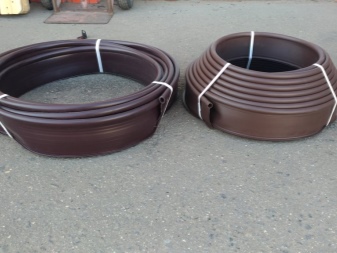
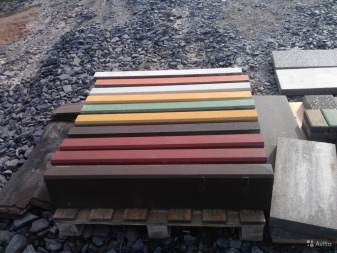
How to do it yourself?
Garden curbs do not have to be purchased from a specialist store. It is quite possible to make them with your own hands and get a very good result in the end. If you want to decorate your summer cottage at low cost, then it is advisable to make the decorations yourself, and then install them yourself, so you can save money on installation. So, for the manufacture of one of the types of border you will need:
- cement grade M400 or M500;
- crushed stone or gravel of fraction up to 40 mm;
- river or washed sand of coarse fraction;
- plasticizer for concrete;
- plenty of water;
- pigment dye for concrete.
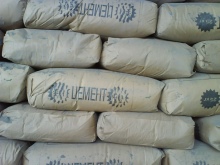
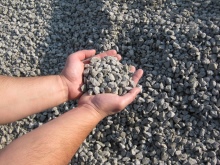
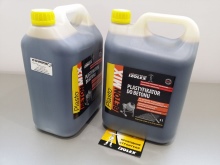
You can also prepare materials to make the formwork - it can be plywood, boards or metal sheets.
Of the tools you will need:
- concrete mixer;
- vibrating table;
- solution tank;
- special forms for pouring concrete mixture;
- roulette, level;
- trowel, shovel, spatula;
- cord, hacksaw and hammer for formwork assembly

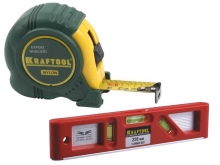
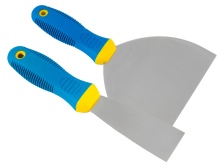
Let us briefly analyze the technology of creating the objects in question with our own hands.
- In the role of a form, it is allowed to use a channel of grade 16 or more. Its ends must be closed by welding metal plates.
- The length of the parts should not be more than 2 m.You shouldn't make them too wide either - they will look rough.
- Next, you need to properly prepare the concrete solution. Better to knead it in a concrete mixer. It is much more difficult to do this with a mixer.
- It is important to use only clean sand and water for mixing.
- To make the finished products easier to get out of the molds, their surfaces inside the walls should be thoroughly smeared with machine oil.
- In order for the cement curbs to turn out to be colored, a coloring component will need to be added to the concrete solution. At each stage of adding certain components, the concrete mixer should continue to work without pauses.
- Really high-quality and neat things can be obtained if you use a special vibrating table. The forms in which the solution was laid are exposed on it. If there is no vibrating table, you can compact the solution by tapping the mold with a hammer.
- If necessary, homemade reinforcement should be made. For this, the forms are first filled with a solution of only 50%, after which metal rods are placed there. Then the remaining space is poured. Next, you will need all the same compaction with a vibrating plate.
- Concrete poured into molds must be left for at least 48 hours. Then the molds are removed, after which the products are left for another 3-4 weeks until ready. When homemade products gain the required level of strength, it will be possible to resort to installing them in the garden.
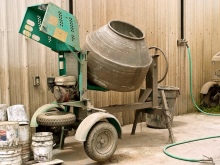
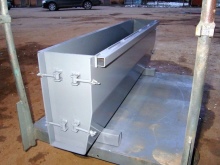
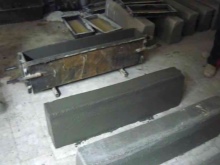
How to bet?
The installation of a homemade curb begins with the removal of the upper layer of soil to a depth of at least half of its height, but at the same time it should at least 1.5 times exceed the height parameter of the resulting product. The site must be correctly placed, the marks must be fixed with wooden pegs and threads stretched between them.
The latter are pulled along the outer edge on the border mounting line.

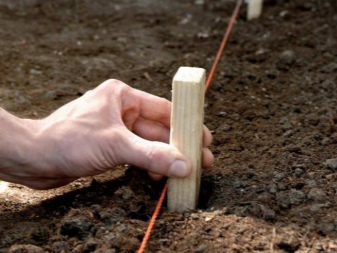
At the bottom of the prepared trench, it will be necessary to fill in 5-8 cm of gravel and sand in layers. Everything is well compacted. Then the composition of cement and sand is kneaded in a ratio of 1: 4. The curbs will need to be installed on the resulting mixture, and then tamped with a special rubber hammer. At this stage, it is very important to keep the horizontal under control in accordance with the string stretched between the pegs and the indicator of the building level. As soon as a whole series of curb components are fully exposed, sand should be poured on both sides of them and spilled with water for density.
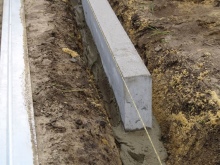
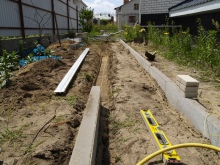
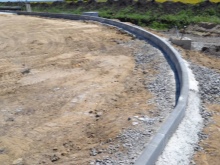
Examples in landscape design
Don't underestimate the role of garden curbs in landscaping. Often, without these details, the composition looks dull, incomplete and even dull. Fences ideally suited to color, shape and size can enliven the setting, make it more vibrant and original. Let's see this by looking at a few good examples.
- Almost the most spectacular and presentable are the borders made of natural stone. Such elements are able to "enrich" almost any garden, as they look expensive and soundly. With such details, you can beautifully fence off a corner from the green lawn, where original ornamental plants grow, surrounded by a small pebble. This corner will find its place next to the front door.
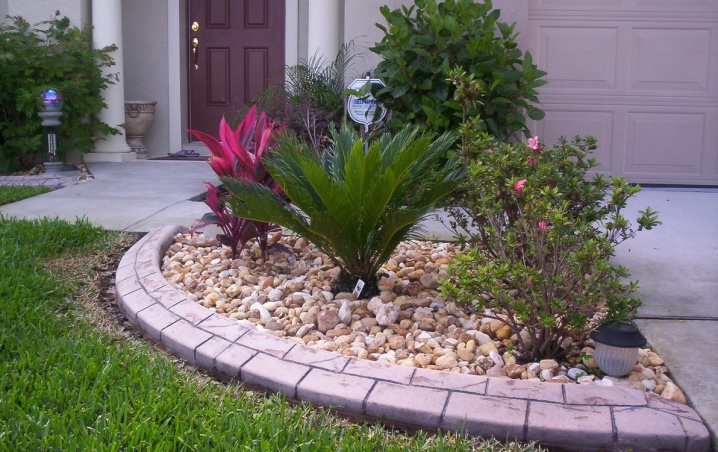
- Curbs made of small hemp arranged in a row look original and attractive on the site. Moreover, their shade can be either light and soft, or darker. All options will look harmonious against the background of garden greenery.
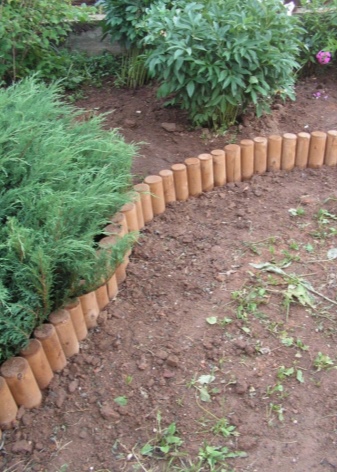
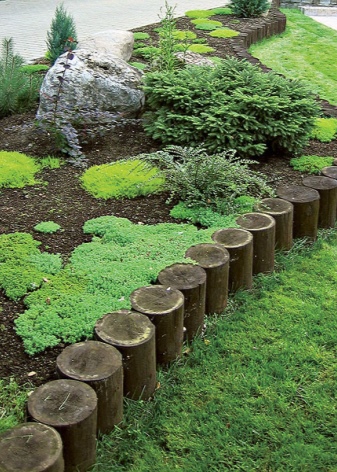
- Plastic curbs of a relief type will look neat and laconic on the local area. Such products are presented in different colors - it will not be difficult to choose the right option for any situation. Plastic parts can be used to enclose a wide variety of green and floral plantings in the garden.
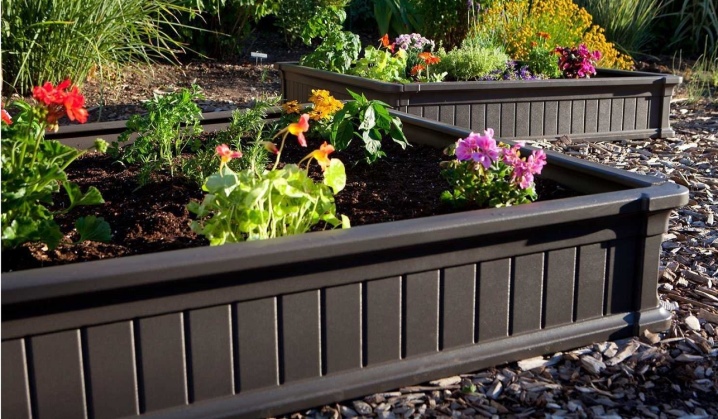
- Very interesting and neat curbs of wavy shapes can be laid out of brick or stone. If you want to bring more interesting colors and shades to the garden, you can paint such fences pale blue, pink, yellow.
Such details will not be annoying with excessive brightness, but they will definitely harmoniously fit into many landscape compositions.
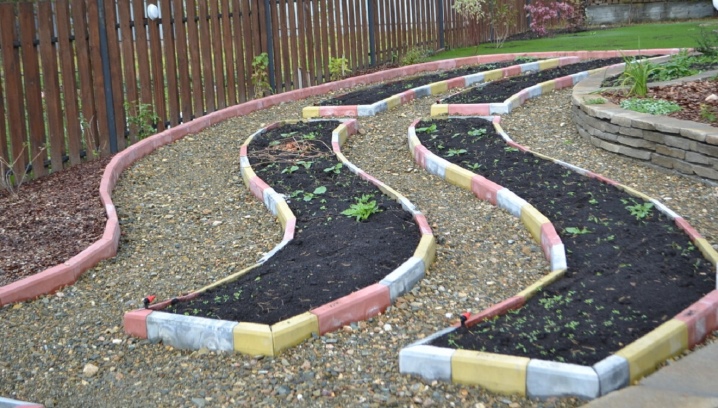
- Plain stone curbs consisting of flat circular elements, will be very attractive and neat to look at the dividing line of a garden path and lush green spaces with multi-colored buds. Best of all, these curbs are combined with a short-cut, well-groomed lawn. With such details, the garden takes on a stunning, well-groomed appearance.
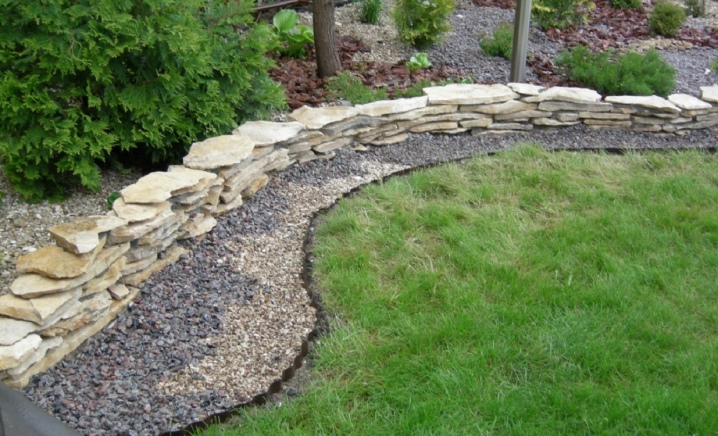
For information on how to make a garden border with your own hands, see the next video.



































































The comment was sent successfully.